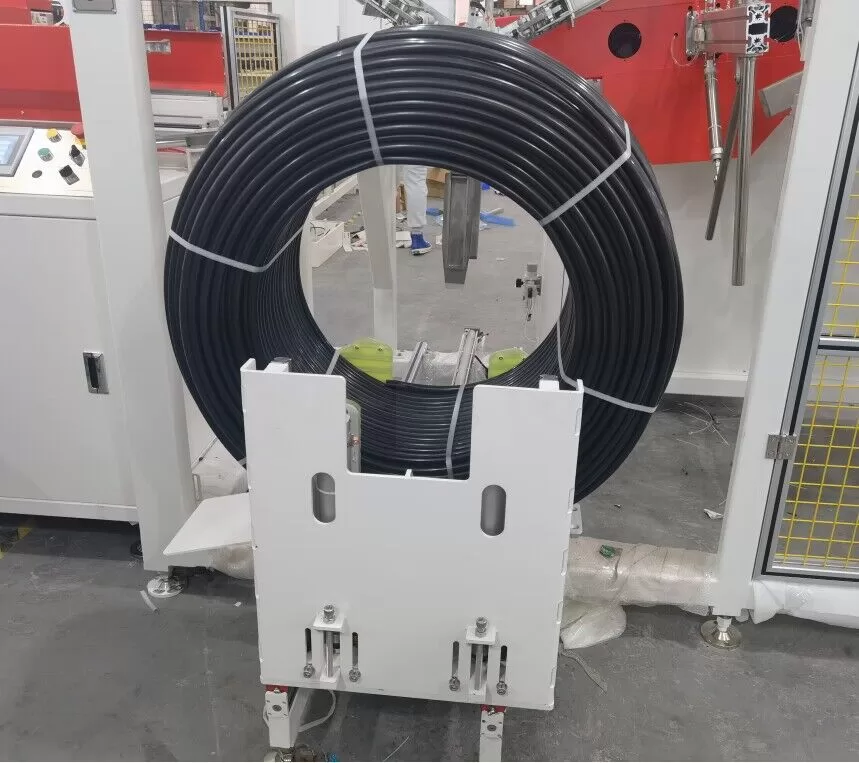Streamlining Operations: Understanding Automated Pipe Coiling and Strapping Systems
Manual handling of pipes, especially in long lengths or large diameters, can be time-consuming, labor-intensive, and pose safety risks. For fabrication shops and manufacturing facilities dealing with significant volumes of plastic pipes (like PE, PEX, HDPE, or corrugated types), automating the coiling and strapping process offers substantial operational advantages. Integrating a pipe coiler with an automated strapping machine creates a seamless downstream solution, improving efficiency and product consistency.
How Automated Pipe Coiling and Strapping Works
These integrated systems typically operate sequentially after the pipe extrusion and cooling stages:
- Pipe Coiling: The pipe is fed into the coiling machine, often guided by sensors and rollers. It's wound around a rotating mandrel or coiling head to form a neat, compact coil of a predetermined length or weight. Advanced systems feature automatic pipe cutting and clamping mechanisms.
- Coil Transfer (if applicable): In some setups, the finished coil is automatically transferred from the coiler to the strapping station.
- Coil Strapping: The pipe coil strapping machine applies one or more straps (typically polypropylene or PET) around the coil's circumference at designated points. The process usually involves feeding the strap around the coil, tensioning it to the desired level, sealing the strap (often via heat or friction welding), and cutting it.
This automation minimizes manual intervention, ensuring a repeatable and efficient packaging process.

Key Operational Benefits
Implementing an automated pipe coiling and strapping system provides several tangible advantages for fabricators:
- Improved Efficiency and Throughput: Automation significantly reduces the time required to coil and secure each pipe length compared to manual methods. This directly increases the overall output capacity of the production line.
- Enhanced Coil Consistency: Machines produce uniform coils with consistent tension and dimensions, improving handling, storage, and downstream usability for customers. Strapping is applied precisely, ensuring secure bundles.
- Reduced Labor Requirements: Automating these tasks frees up personnel from repetitive manual labor, allowing them to focus on higher-value activities. It also reduces ergonomic strain and potential injuries associated with handling large or heavy pipe coils.
- Material Handling Versatility: These systems can often be configured to handle a range of pipe diameters, materials (from flexible PEX to more rigid HDPE), and coil size specifications.
- Consistent Package Security: Automated strapping ensures that each coil is secured with the correct tension and strap placement, protecting the product during transit and storage and reducing the risk of damage or unraveling.

automatic pipe coiling machine, automatic hose coiling machine2 Considerations for Implementation
When evaluating automated pipe coiling and strapping solutions, consider the following factors:
- Pipe Specifications: Define the range of pipe diameters, wall thicknesses, and materials the system needs to handle.
- Coil Requirements: Determine the target coil inner/outer diameters, widths, weights, and required strapping patterns (number and position of straps).
- Throughput Needs: Match the machine's speed capabilities (coiling speed, strapping cycle time) with your production line's output rate.
- Level of Automation: Decide on the required degree of automation – from basic coiling and manual strapping initiation to fully integrated systems with automatic coil ejection and transfer.
- Strapping Material: Choose the appropriate strapping type (e.g., PP, PET) and size based on coil weight and required strength.
- Footprint and Integration: Ensure the equipment fits within the available floor space and can be effectively integrated into your existing production workflow.
For fabricators looking to optimize their pipe handling and packaging processes, exploring automated solutions like a combined pipe Coiler & pipe coil strapping machine is a crucial step. By carefully assessing production needs and selecting the right equipment, manufacturers can achieve significant improvements in efficiency, consistency, and operational safety.
